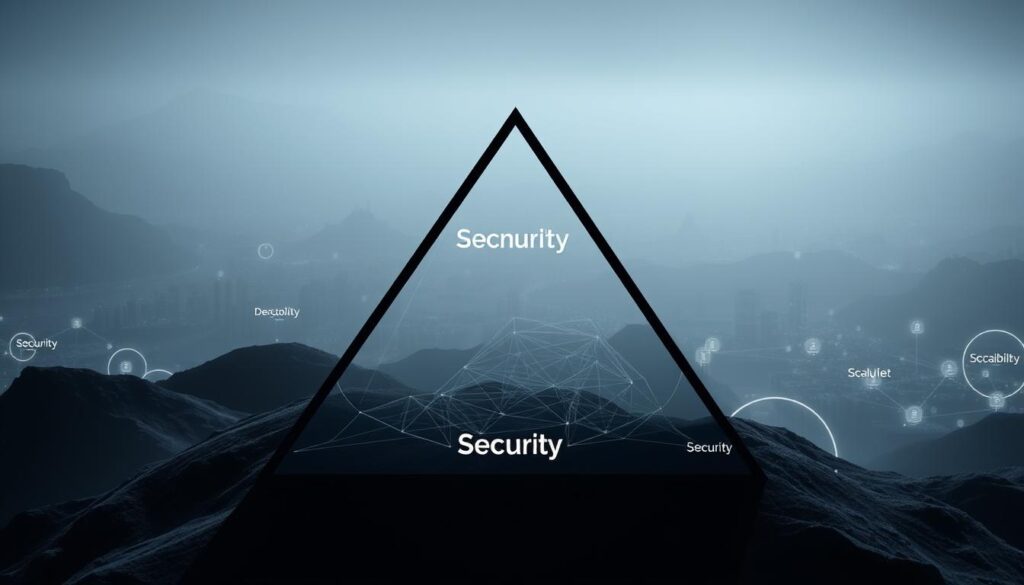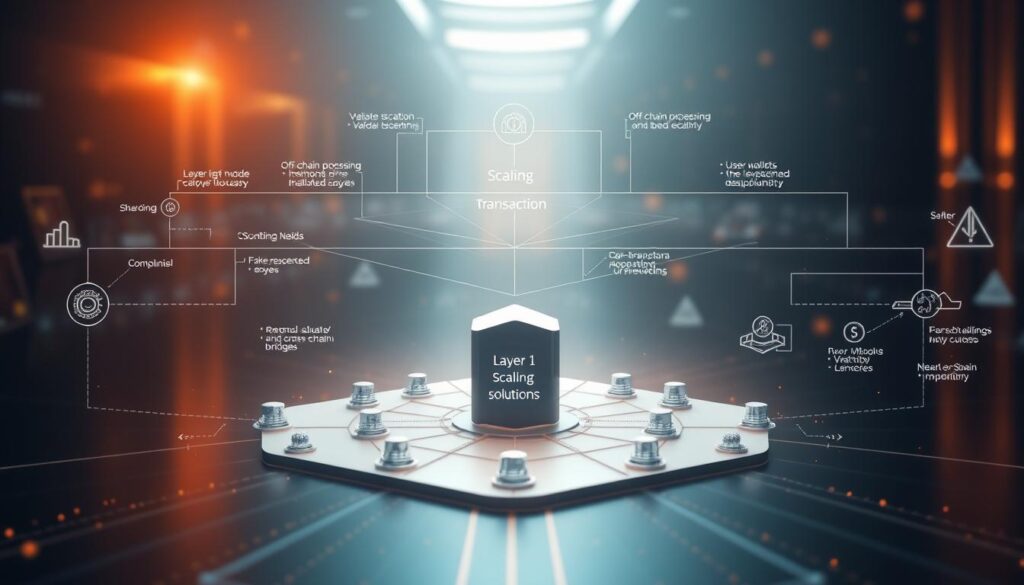The digital currency revolution now impacts over 420 million people globally. This explosive growth exposes critical infrastructure limitations in decentralized systems. Traditional networks process fewer than 10 transactions per second, while payment giants like Visa handle thousands effortlessly.
This performance gap creates real-world frustrations for users. Imagine waiting hours for coffee payments to clear during morning rush hours. The core challenge lies in balancing three vital network qualities: security, decentralization, and transaction capacity. Developers call this the scalability trilemma – no system currently masters all three.
Two distinct approaches emerge to address these limitations. Base-layer enhancements modify core network operations, while secondary frameworks build atop existing chains. Each method carries unique trade-offs in speed, costs, and system integrity.
Understanding these strategies matters as crypto adoption accelerates. Recent surveys show 16% of Americans now own digital assets. Without efficient processing systems, mainstream acceptance faces significant roadblocks. This analysis explores how different technical philosophies tackle one of modern finance’s most pressing challenges.
Introduction to Blockchain Scalability
Digital networks face a critical challenge as adoption surges: maintaining speed while growing. When systems can’t keep up with demand, everyday users feel the strain through delayed payments and rising fees. This bottleneck threatens to slow innovation across finance, gaming, and other sectors.
Defining Scalability and Its Importance
A network’s capacity to manage growing activity without lag defines its scalability. Think of it like highway lanes – more users require wider roads to prevent traffic jams. Many decentralized systems hit walls at 10-30 transactions per second, while credit card networks handle thousands effortlessly.
Growth Demands New Approaches
User bases have exploded 600% since 2018, pushing existing infrastructure to its limits. During peak times, confirmation delays now average 7-15 minutes across major networks. These delays stem from design choices prioritizing safety over speed – a trade-off that frustrates newcomers expecting instant payments.
| Metric | Traditional Systems | Current Networks | Target Performance |
|---|---|---|---|
| Transactions/Second | 24,000 | 7-30 | 100,000+ |
| Confirmation Time | 2-5 seconds | 10+ minutes | Under 1 second |
| Active Users Supported | Billions | Millions | Billions |
These gaps explain why developers are racing to implement new scalability approaches. The stakes keep rising – analysts predict 1 billion crypto users by 2030. Without major upgrades, networks risk becoming victims of their own success.
Understanding the Scalability Trilemma
Network architects face an impossible choice when building decentralized systems. They must prioritize two features while compromising the third – a fundamental constraint called the scalability trilemma. This principle dictates that no network can simultaneously maximize security, decentralization, and transaction speed.

Balancing Security, Decentralization, and Throughput
Validator numbers reveal how chains manage trade-offs. BNB Chain uses just 21 validators for rapid processing but risks centralization. Solana employs 1,900 nodes for better distribution, while Ethereum’s 500,000 validators create ironclad security at the cost of slower transactions.
These choices directly impact user experience. Systems favoring speed and decentralization become vulnerable to attacks. Networks prioritizing safety often struggle with high fees during peak usage. There’s no perfect solution – only strategic compromises.
Insights from the CAP Theorem
Computer science’s CAP theorem mirrors this challenge. Distributed systems can’t achieve consistency, availability, and partition tolerance simultaneously. Like blockchain architects, database engineers must choose which two qualities matter most.
Ethereum’s design emphasizes security and decentralization, accepting slower speeds. BNB Chain flips this formula, optimizing for fast transactions by reducing validator participation. Each approach serves different needs while exposing unique weaknesses.
Layer 1 Blockchain Networks: Core Scaling Solutions
At the heart of every crypto system lies its base protocol layer. These foundational networks handle transaction validation, data storage, and network rules independently. Unlike add-on solutions, they maintain complete control over their operational framework.

Main Chain Architecture Essentials
Primary networks like Bitcoin and Ethereum operate through three key components. Their peer-to-peer structure ensures global access without central servers. Data availability layers store complete transaction histories across all nodes, while consensus rules govern validation processes.
| Network | Transactions/Second | Energy Use | Active Validators |
|---|---|---|---|
| Bitcoin | 7 | High | 15,000+ |
| Ethereum | 32 | Low | 500,000+ |
| Solana | 2,800 | Medium | 1,900 |
Evolution Through Protocol Changes
Major upgrades demonstrate how base layers adapt. Ethereum’s 2022 shift to proof-of-stake slashed energy use by 99.95% while boosting capacity. This overhaul required coordinated action across developers and users worldwide.
Bitcoin’s 2017 SegWit update showcases another approach. By restructuring transaction data, it effectively doubled capacity without changing block size. Such modifications prove that even established networks can evolve their core mechanics.
These foundational improvements create ripple effects across entire ecosystems. As base layers grow more efficient, they enable new layer 2 investment opportunities and applications. The race for better main chain performance continues driving crypto innovation forward.
Key Techniques and Trade-Offs in Layer 1 Scaling
Modern networks require bold solutions to handle increasing user demands. Developers employ two primary strategies to boost base-layer performance: structural partitioning and block expansion. These methods aim to relieve congestion while maintaining core network principles.

Sharding: Parallel Processing Potential
Sharding splits networks into specialized segments called shards. Each shard processes transactions independently, like multiple checkout lanes at a grocery store. This parallel approach could multiply transaction capacity without requiring every node to validate all activity.
Ethereum’s ongoing sharding project highlights both promise and complexity. The network plans to divide its workload across 64 segments, theoretically boosting speeds 64-fold. However, coordinating cross-shard communication and maintaining security remains challenging. No major network has fully implemented this technique yet.
Block Size Adjustments: Immediate Gains, New Challenges
Bitcoin Cash’s 2018 upgrade demonstrates block expansion’s immediate impact. By increasing block size from 1MB to 32MB, the network now handles 120 transactions per second – 17x faster than Bitcoin. This simple change requires minimal technical overhaul but introduces new issues.
| Network | Block Size | Transactions/Second | Active Nodes |
|---|---|---|---|
| Bitcoin | 1 MB | 7 | 15,000+ |
| Bitcoin Cash | 32 MB | 120 | 1,200 |
Larger blocks demand more storage and bandwidth, potentially reducing node operators. Fewer participants could lead to centralization – exactly what decentralized networks aim to prevent. This trade-off forces developers to balance speed gains against network health.
- Sharding benefits: Theoretical massive capacity gains, preserves decentralization
- Sharding challenges: Cross-shard coordination, delayed implementation
- Block size pros: Immediate speed improvements, simple execution
- Block size cons: Hardware demands, centralization risks
Layer 2 Blockchain Scaling Solutions Explained
Alternative processing methods unlock new possibilities for digital networks. These systems handle transactions away from primary chains while maintaining security links. This approach keeps core protocols intact while boosting performance.

Instant Settlement Through Encrypted Pathways
State channels create private transaction corridors between users. Bitcoin’s Lightning Network demonstrates this concept, enabling micropayments at 1 million operations per second. Participants lock funds in multi-signature wallets, then exchange unlimited transactions offline.
Batch Processing Advancements
Rollup systems bundle hundreds of transactions into single verifiable packages. Zero-knowledge variants like StarkNet use cryptographic proofs to validate 100,000+ actions per second. Optimistic rollups, used by Arbitrum, assume validity unless challenged – balancing speed with dispute resolution.
| Solution Type | Example | Transactions/Second | Security Method |
|---|---|---|---|
| State Channels | Lightning Network | 1,000,000 | Multi-sig Escrow |
| Nested Chains | Ethereum Plasma | 5,000 | Fraud Proofs |
| ZK-Rollups | StarkNet | 100,000 | Cryptographic Proofs |
| Optimistic Rollups | Arbitrum | 40,000 | Challenge Period |
| Sidechains | Polygon | 65,000 | Validator Pool |
These methods demonstrate how secondary systems complement primary networks. Polygon’s sidechain processes 65,000 transactions using independent validator groups. Each approach maintains different security guarantees while expanding throughput capacities.
Developers continue refining these techniques to support global adoption. The diversity of options allows projects to choose optimal balances between speed, cost, and decentralization requirements.
Blockchain scalability solutions comparison Layer 1 vs Layer 2 protocols
Two architectural philosophies dominate efforts to improve transaction capacity in decentralized systems. Base-layer modifications rework core mechanics, while supplementary frameworks enhance existing infrastructure through external processing.
Methodologies and Scalability Methods Compared
Primary network upgrades involve fundamental protocol changes. Consensus shifts like Ethereum’s move to proof-of-stake require majority network approval. Chain forks and sharding implementations alter how data gets stored and verified across nodes.
Secondary systems operate through parallel processing layers. State channels enable off-chain transactions through encrypted pathways. Rollups batch hundreds of actions into single verifiable packages, while sidechains handle bulk operations independently.
| Feature | Base-Layer Adjustments | Supplementary Frameworks |
|---|---|---|
| Implementation Time | Months-Years | Weeks-Months |
| Network Consensus Required | Yes | No |
| Security Source | Native Protocol | Parent Chain |
Key distinctions emerge in deployment flexibility:
- Core modifications face political hurdles but enable permanent upgrades
- External solutions deploy faster but rely on underlying network security
Projects often combine both approaches. Base-layer improvements create stable foundations, while secondary systems address immediate throughput needs. This hybrid strategy balances long-term vision with practical performance demands.
Comparing Benefits, Risks, and Security Aspects
A $570 million breach on BNB Chain in 2022 exposed critical vulnerabilities in modern network designs. This incident – among the largest crypto heists – revealed how scaling choices impact user funds and trust. Both base-layer upgrades and supplementary frameworks carry distinct security profiles that shape adoption risks.
Trust Assumptions Across Architectures
Base-layer systems like Ethereum prioritize inherent security through decentralized validation. Their 500,000+ validators create attack-resistant networks but limit transaction speeds. Chains with fewer nodes, like BNB’s 21-validator model, face higher centralization risks – a trade-off for faster processing.
External frameworks depend on parent chains for protection. Polygon’s 2021 whitehat discoveries showed how sidechains introduce new weak points. Arbitrum’s bridge flaw demonstrated that even advanced rollups inherit risks from connection points. These layers add complexity but enable faster innovation cycles.
| Security Factor | Base-Layer Systems | Supplementary Frameworks |
|---|---|---|
| Validation Nodes | Thousands+ | 10s-100s |
| Attack Surface | Protocol Rules | Bridge Contracts |
| Upgrade Process | Community Consensus | Developer Teams |
Developers choosing base-layer solutions gain ironclad security at the cost of slower upgrades. External systems offer agility but require audits for smart contracts and cross-chain bridges. Recent incidents prove no architecture is immune to exploits.
Network integrity hinges on balancing these factors. Projects favoring speed often consolidate control among fewer validators – a risky centralization trend. Systems prioritizing decentralization must educate users about slower transaction confirmations and occasional congestion fees.
Real-World Examples and Case Studies
Practical implementations reveal how digital networks evolve to meet growing demands. Major projects demonstrate diverse approaches to boosting transaction capacity while maintaining security standards.
Ethereum’s Energy Revolution
Ethereum’s 2022 upgrade slashed energy consumption by 99.95% through its proof-of-stake shift. This overhaul increased network participation to 500,000+ validators while improving transaction finality. The change enabled 65,000+ daily operations without compromising decentralization principles.
Speed Champions in Action
Bitcoin Cash’s 32MB block expansion supports 120 transactions per second – 17x faster than Bitcoin. Polygon’s sidechain handles 65,000 actions using independent validator groups. StarkNet’s ZK-rollups process complex computations off-chain, achieving enterprise-grade throughput.
These instances highlight three key patterns:
- Protocol changes require consensus but enable permanent upgrades
- External frameworks offer rapid deployment with parent-chain security
- Hybrid models combine base-layer stability with supplementary speed
Lightning Network’s million-transaction capacity demonstrates how specialized layers address specific use cases. As networks adopt tailored strategies, they create ecosystems where multiple solutions coexist to serve different needs.
FAQ
What is the scalability trilemma in distributed networks?
The trilemma refers to the challenge of balancing three critical features: security, decentralization, and transaction throughput. Enhancing one often compromises another. For example, increasing block size to boost speed may reduce decentralization by requiring more expensive hardware for nodes.
How do sharding and rollups differ in improving network efficiency?
Sharding splits a main chain into smaller partitions (shards) to parallelize operations, reducing congestion. Rollups bundle multiple off-chain transactions into a single on-chain proof, leveraging the base layer’s security while boosting processing capacity. Ethereum uses both strategies in its roadmap.
Why did Ethereum transition from Proof-of-Work to Proof-of-Stake?
The shift to PoS aimed to cut energy use by 99% and improve throughput. Validators now stake ETH instead of solving computational puzzles, enabling faster consensus. This change also laid groundwork for future upgrades like sharding, which complements Layer 2 solutions like Optimism’s rollups.
Can Layer 2 systems like Polygon compromise decentralization?
While some protocols use centralized sequencers for speed, others prioritize decentralization. For instance, StarkWare’s validity proofs ensure trustless verification without revealing transaction details. Trade-offs exist, but hybrid models balance speed and integrity.
What role do state channels play in reducing on-chain load?
State channels let users transact off-chain, settling final results on the main network. Bitcoin’s Lightning Network uses this to enable instant micropayments. Only opening and closing transactions hit the base layer, freeing block space for other operations.
How does BNB Chain achieve high transaction volume?
BNB Chain employs a modified Proof-of-Staked-Authority consensus, where 21 validators process blocks rapidly. This semi-centralized model allows ~5,000 TPS but sparks debates about decentralization. Its efficiency suits applications prioritizing speed over strict node diversity.
Are sidechains secure compared to main networks?
Sidechains like Polygon PoS have independent security models. While they benefit from Ethereum compatibility, their consensus mechanisms may differ. Users must trust the sidechain’s validators, unlike rollups, which inherit Ethereum’s security through cryptographic proofs.


No comments yet